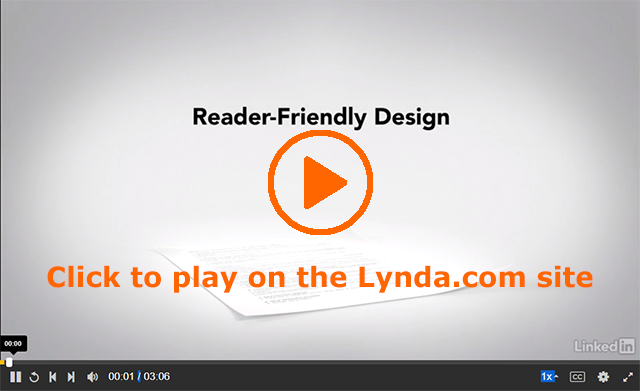Lynda.com Login Help
Lynda.com videos are free to Virginia Tech students with your VT.EDU login. Start at the VT.EDU login page to access these resources.
This week’s #WeekendWatch demonstrates how Reader-Friendly Design (4m40s) can improve a proposal, making it more likely that readers will consider the document fully.
The video shows a before and after version of a chunk of text from a proposal and walks through the changes that make the original document easier to read. The video shows why it’s important to pay attention to paragraphing, headings, and document structures like bullet lists for a reader-friendly design.
Watch the video for more information on strategies that you can apply in your short proposal.
Note: This video has closed captioning, so it does not need a transcript.

5 Comments
I liked this video because it was informative on how to write a proposal and the goals of it. I thought it was similar to other videos we’ve seen because it talked about the format of the writing and how it should have subtitles and headings that can break up the page. I think it incorporates the stylistic properties that most proposals have, and it also shows how the point of the proposal needs to be clear. This ties in to the article from the other day about how the proposal needs to meet three goals which include writing for the audience and not yourself, and making sure your purpose is clear. If you don’t have a clear purpose then it doesn’t even matter if the style of the paper is cohesive. The content of it is the most important, followed by being able to see the style of the paper. The reader friendly design will make people want to read the proposal and not be stuck wondering what they’re reading. That’s important because you’re trying to persuade them to take interest in your proposal, so making it reader friendly will definitely help in that aspect.
From this video I learned that two of the top ten reasons that proposals are turned down are because the proposal doesn’t have an overall design nor does it follow the required format. In the video they added section headers to make it easier to read specific sections, instead of just having one paragraph that includes everything. Sometimes adding information in a listed format can help it be easier to read and to find what you are looking for. Font size is generally size 12, however when it comes to headers the can be a little bigger and bold to help make them stand out. Also, you have to make sure your wording is clear and straight to the point so the reader will easily understand it. At the end of the video it mentions that if the reader can read the proposal easier and quickly, usually the happier the reader. So what I learned that I can apply on my proposal is to make sure my sections are short and to the point and don’t drag on forever. This will help make the reader (the professor) happier and that means more likely she will approve what I am proposing.
Although this was intended for writing a proposal, the messages in the video support what most of the other discussion posts have said. We are essentially “selling” our writing to the customers (Readers), and customers want easy, practical products. If we keep the reader in the back of our minds when we are writing, our work will be improved. We need to focus on the essentials and organize our key points. This video basically is saying that readability and format is more important than content. In the example with the two similar sentences, the one that readers “like better” is the simpler, but less eloquent sentence. This may be specific to proposal but it is a good message that “less is more.”
I did learn a few things from this video that I didn’t anticipate. I didn’t know that even in the appendices you need to keep things short and simple, but I guess it makes sense that the rules of proposal writing apply to the entirety of the product. I agree with the people who commented before me in the discussion–a trend in this course seems to be how to best write to sell something. I’m realizing more and more that technical writing is all about the most efficient way to effectively make a point, whether it’s an email, presentation, or proposal.
Many of the concepts in this video reminded me a lot of the concepts we covered in the modules about writing good email. Formatting and ensuring that information is visually appealing is a must. One thing that we covered in when speaking about emails that was covered in this video was bulleted lists versus paragraphs. Bulleted lists for things such as budgets look a lot neater and much more manageable, which I think is important because even if the content of a proposal was good, it could still be viewed poorly if the formatting is bad.